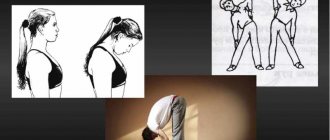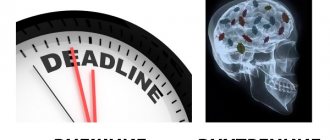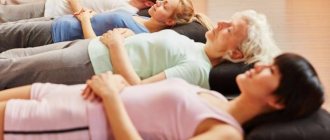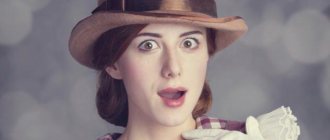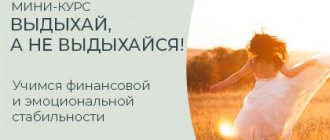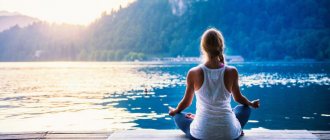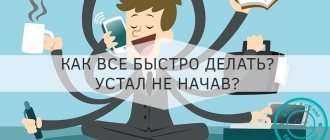From this article you will learn:
- What signs indicate that you need to relax your body?
- What types of relaxation are there?
- What are some ways to relax your body and mind?
- How to relax the body by influencing specific points
- How meditation helps in relaxing the body and mind
- How to Prepare for Meditation
- What other exercises will help you relax?
Mental and physical stress that arises as a result of fairly long and intense work, as a rule, is relieved by various types of rest. Both mental and physical activity are vital and useful, if they do not exceed certain limits, individual for each person. Particular attention requires tension in the body and nervous system caused by emotions, the strength of which varies from person to person. Excess emotions, both positive and negative, affect health. The most natural way to minimize their negative impact is through relaxation. Next we will describe methods and technologies that ensure relaxation of the body.
What is relaxation?
Relaxation is considered to be a response to the ever-accelerating pace of life and the emergence of a large number of external negative factors. Interest in it increased in the second half of the twentieth century, but methods and methods of relaxation have been used since ancient times. Relaxation is understood as a means of relieving muscular and psychological tension, which is expressed in various methods and techniques that can be divided into three groups - medicinal, physiotherapeutic and psychophysiological.
The relaxation effect is achieved only as a result of actions, i.e. simply resting (the “doing nothing” beloved by many) will not lead to the expected results. Medicinal technology involves the use of special drugs, but their use is recommended only in exceptional cases (there are a large number of contraindications).
Physiotherapeutic technology provides muscle relaxation through spa treatments, special massage, soft laser, etc. This area is in demand not only for relieving stress, but also for solving cosmetic problems caused by stressful situations. Physiotherapeutic methods in most cases require visiting salons, spa centers and other similar establishments, so this is not always convenient.
A psychophysiological technique based on a person’s ability to control body processes allows one to achieve relaxation independently. Psychophysiological methods and techniques are in demand because all that is needed to use them is a comfortable environment, some free time and comfortable clothing.
A set of exercises to relax facial muscles
In addition to exercises to relax your body muscles, it is important to take care of your face. Daily training and relaxation of the muscles of the cheekbones, cheeks and forehead will help improve blood circulation, reduce wrinkles and tone the skin.
If you don’t know which exercises to relax your facial muscles are right for you, we suggest using the following complex. It should be performed in a calm, relaxed state. It is important to monitor your breathing during exercise so that it always remains slow and deep. Feel the state of relaxation in the areas you are working on.
Before class, take the most comfortable position.
Cheek exercises
- Inhale and with your eyes closed, try to raise your eyebrows as high as possible. Hold this position for a few seconds and exhale, lowering your eyebrows. Next, complete relaxation and repeat the exercise.
- Taking a deep breath, strongly tense the wings of your nose. Then exhale and relax. Repeat several times.
- Open your mouth slightly and lift one corner of it up (you will get a “crooked” smile). Hold the grimace for a few seconds, then relax. Repeat these steps on the other half of your face.
- Wink your eyes alternately.
- Wrinkle your face tightly, hold this position for a few seconds, then relax.
- Using your fingers, slowly pull your upper lip down. Without releasing your grip, try to smile. You will see how your cheeks tense up.
Experts at the Witch's Happiness store recommend:
Living incense “Feminine power” Natural incense made from herbs and resins
125 rub.
buy
Bracelet “Sea Breeze” Handmade bracelet with starfish pendants
890 rub.
submit your application
Eye exercises
- Inhale and close your eyes. Slowly strain your eyes harder and harder until you close your eyes. Hold this position for a few seconds, then exhale and relax. Repeat several times.
- Perform circular movements with your eyes while keeping your head still. It is necessary to make three to five circles in each direction.
- When looking straight, fix the level position of your head. Next, without changing it, look up and down. Repeat several times.
- The starting position is the same as in the previous exercise, but the gaze moves not up and down, but right and left. Several repetitions are also necessary.
Exercises for the mouth muscles
- Perform the “air kiss” several times: curl your lips into a tube and imitate a kiss.
- Pronounce the sounds “a-a-a”, “o-o-o”, “u-u-u”, “uh-uh”, “i-i-i”, “y-y-y” in a drawn-out manner. , actively articulating in accordance with them.
- Open your mouth slightly and try to turn your lips inward. Maintain the position for a few seconds, then relax. Several repetitions are required.
- Smile with your mouth closed, first with the right, then with the left, then with both sides of your mouth at once. Repeat several times.
- Open your mouth slightly and firmly pull one corner to the side. Repeat the same movement on the other side of your mouth.
- Fix the corners of your mouth with your fingers and then smile through resistance. Repeat at least 20 times.
What are the benefits of relaxation?
The purpose of relaxing muscles and relieving psycho-emotional tension is to relieve stress and restore strength. It is no coincidence that relaxation is considered one of the most effective ways to increase performance: with the right approach, high physical and mental activity is ensured. Exercises are also recommended if you have hypertension. Special techniques allow muscles to relax, thereby minimizing the risk of destructive processes in muscle tissue and psychosomatic disorders.
Thus, relaxation therapy helps restore and maintain physical health (many diseases are caused by constant muscle and psychological tension). As a result of regular exercise, your health improves, headaches go away and blood pressure normalizes. Relaxation exercises are also recommended for those people who suffer from insomnia and increased anxiety.
Meditation for deep relaxation of mind and body
Simply put, meditation is the process by which a person enters a trance state.
There are a large number of meditation techniques that provide effective relaxation.
Among them are meditations that are intended solely for relaxation and protection from stress. Using such technologies, you can not only improve your physical health, but also improve your psychological state. The European version of meditation is also called auto-training.
The meditation room must also be carefully prepared:
- wash the room and ventilate it well;
- darken the room as much as possible;
- light incense sticks or use incense with good Indian, Chinese or Japanese oils;
- ask your loved ones not to disturb you.
Let's first get acquainted with the simplest meditation technique, which uses a burning candle. Sequencing:
- Turn off light sources and close windows with thick curtains.
- Sit more comfortably, trying to keep your back straight. It is advisable to take the lotus position.
- Take out the candle. Place it at arm's length, at eye level. Light a candle.
- Concentrate your attention on the tip of the fire. Try not to blink. Allow your eyes to water, this is normal.
- Let the flame gradually fill your consciousness, eliminating unnecessary thoughts. Imagine that your troubles and negative emotions are burned in a fire.
- Close your eyelids and mentally reproduce the image of a flickering light.
- We open our eyelids. We look away from the flame for a few seconds, and then again watch the flow of flame.
- We open our eyes. Let's take a few deep breaths.
Session duration is from 15 minutes.
In the Indian version of meditation practice, sutras are used, special phrases that help relax the body:
- I move through life easily and freely, allowing it to support me, nourish me and heal me;
- I feel calm and strong, like a rock in the sound of the surf.
The most commonly used are mantras - special combinations of sounds in a certain sequence. At the same time, it is a sacred text, a word or a syllable, a type of ancient prayer in Sanskrit.
Every sound has its own vibration frequency. Many mantras begin and end with the sound OM (Aum). The sound OM is believed to correspond to the vibration of the Universe.
mantra Om is simple in composition: OM MANI PADME HUM . But the meaning of its parts is impressive: OM – removes pride and conceit; MA – removes jealousy and envy; NI – removes attachment and selfish desires; PAD – dispels ignorance and confusion; HUM – heart, behavior leading to salvation.
Chanting the Om mantra calms the soul and brings a person’s inner world into harmony with the Universe.
The total number of mantras is in the thousands. Each of them, like a prayer or song addressed to the Gods, has its own goal - the fulfillment of desires.
Let's move on to consider the most popular meditation techniques.
Meditation to relax the body
Sit back and imagine yourself in a forest clearing full of sun and bright flowers. The warm air is filled with aromas. Let's continue:
- Completely relaxed. Carefully inhaling the aromas of the forest, we are filled with feelings of freedom and peace. Quiet. There is only me and nature.
- A dragonfly flies by - a thunderstorm of mosquitoes. I wonder how old the tall anthill at the edge of the clearing is: 50, 100? Its inhabitants scurry along their routes. All passages are open and no rain is expected.
- An ant is running along the sleeve of his shirt. He climbed high. You can’t say anything about him: he went out for a walk. Probably a scout. Let's shake him off to his relatives. Otherwise he will climb up your collar and, pinned down, bite. Everything is fine. A woodpecker knocked nearby and found work. And I'm relaxing.
- Having enjoyed the memories of nature, we return, refreshed. We're home again. Breathe deeply and freely. We stretched ourselves.
We smiled. Ready for work.
Meditation to relax and heal the body
Any emotion finds a response from the body. Stress leads to muscle and tendon tension, changes in heart rhythm, spasms, and metabolic disorders. The proposed technique is aimed at simultaneously relaxing and healing the body:
- First of all, we will try to establish normal breathing. We take deep, rhythmic breaths in and out in a comfortable position with our eyes closed.
- Relax the muscles of the face and neck. Relaxed, they become soft and warm. At the same time, your legs and arms become heavier. The heat is rising.
- Your body has lost feeling in your limbs. Gentle influxes of warmth come to the heart, it beats evenly and calmly. Convince yourself that you have entered a state of absolute peace without thoughts or feelings. You are calm.
- We are gradually emerging from the newfound state: we felt our legs and arms, then our whole body. We open our eyes and slowly rise.
Body Awareness
Feeling your body and every part of the body is a very effective technique that combines rest and relaxation. The sequence of actions in this case:
- Take a comfortable position, trying to keep your back straight. You can lie down if you are going to move from meditation to a state of restful sleep.
- Let's take a deep breath. As you exhale, imagine that all tension is leaving your body.
- Focus on the tips of your toes. Imagine how your breath fills them with warmth and energy.
- We relax our legs, move to our knees, then to our arms, back and face, each time adding a surge of warmth to these parts of the body. We stopped at the top of the head.
- We feel how the warmth covered the whole body, giving it an enveloping relaxation. Maintain this state for another 10 minutes before leaving the meditation.
Relaxation methods
Since psychophysiological relaxation is considered to be the most accessible and popular technique, let’s consider the main relaxation methods within this area. So, the following relaxation methods are most widespread:
- muscular;
- mental (or figurative);
- respiratory.
The first method is to relax the muscle tissue, which occurs after preliminary tension. The meaning of the technique is that a person needs to tense his muscles (one or several groups) for 5-10 seconds, and then concentrate on relaxing them for 15-20 seconds.
The method of Dr. E. Jacobson (he developed progressive muscle techniques) includes more than two hundred exercises that are aimed at working with various muscles. The exercises are initially focused on working with muscles at the physical level, but regular exercises help a person develop the ability to relax through volitional effort.
Mental relaxation technique is a part of the meditation process that helps you relax by creating various mental images. A simple method, which is often used on a subconscious level, is breathing. Its meaning is to take breaths that help overcome anxiety and develop the correct type of breathing. The technique of performing the exercises may vary depending on the chosen direction of respiratory relaxation.
Deep body relaxation: 7 key practices
Deep relaxation of the body muscles plays a leading role in psychotraining, as it allows a person to gain a sense of calm and confidence, fully restore strength and recharge with energy.
With the help of deep relaxation, a most valuable skill is achieved: the ability to purposefully control your body and bioenergetic processes.
First of all, you should learn to feel yourself, the state of your body and manage it. This can be achieved with the help of special exercises to relax the muscles of the body and the entire muscular system. After you learn to relax individual muscles of the body (face, mouth, back of the head, spine), begin to stretch all the muscles from the bottom up, from the feet to the head.
There are many deep relaxation practices. The most effective of them: deep breathing, progressive relaxation of body muscles, meditation, visualization, yoga, tai chi, self-massage.
Any relaxation method takes at least 10 minutes a day. However, in cases where you are exposed to constant stress, when you begin to be overcome by depression or any phobias, devote yourself, your loved one, a whole hour to more thoroughly relax the muscles of the body and calm the nervous system.
Enter a special column “Relaxation/Meditation/Visualization” into your daily routine and practice one of the methods you like every day, at the time allocated for classes. The best time for this is in the morning, when your head is still half asleep.
Do not engage in relaxation procedures if you are tired and want to sleep, since relaxation is a process that requires complete concentration and constant presence “here and now.”
When you choose a relaxation technique that you like and think is what you need, ask your body if it is the right choice.
Choose one of two options for classes: alone or in a group with people close and interesting to you. Each of these options is good in its own way; Over time you can change your choice.
Let's consider sequentially the seven most effective and popular practices (techniques) of deep body relaxation.
Deep breathing
The breath that originates in the stomach smoothly moves into the chest and, as you exhale, rests on the sky.
This practice, despite its apparent simplicity, is very effective when carefully implemented, and it is no coincidence that it underlies a number of psychophysical techniques: yoga, tai chi, wushu. The effects of deep breathing are enhanced and transformed into a pleasant magical effect when combined with aromatherapy and meditative music.
A more detailed description of the time sequence of the process of relaxation of the body and soul based on deep breathing:
- Sit up straight, put one hand on your stomach, the other on your chest. We begin to inhale air through our nose so that at first only the hand on the stomach moves upward. After “saturating the abdomen,” we move to the thoracic part of the body. This time the hand on the chest moves involuntarily. Then we slowly fill the upper part of our lungs with air and begin to exhale air through our mouth.
- When we complete the exhalation, we squeeze the abdominal muscles, as if squeezing out all the air. At the same time, the hand on the stomach should feel how it is released.
- We repeat the cycles of inhalation through the nose, exhalation through the mouth for 5-10 minutes, until you want to stop.
If at the initial stage you find this process difficult, you can make the initial situation easier. Try lying down, place a book on your stomach and watch how it rises and falls. The practice of deep breathing does not just lead to relaxation - it is also an effective prevention of tuberculosis and other pulmonary diseases. With deep breathing, all parts of the lungs are completely saturated with oxygen, and not just the top, as happens with normal shallow breathing.
Note that something similar happens when swimming in classical styles, and it is not for nothing that this sport has a pronounced healing effect.
Progressive relaxation of body muscles
In short, it is a technique of alternately tensing and relaxing all the muscles of the body (which we can control).
By consistently performing progressive relaxation of individual muscles of the body, we learn to monitor the tone of the body and areas of tension, trying to expel this tension from ourselves. Constant muscle tension, which previously appeared as a result of prolonged stress, negatively affects the nervous system. By forcing the muscles of the body to tense again, we teach them to relax and calm down.
Most progressive relaxation practitioners advise starting with the feet and working through the entire body from the bottom up. Sequence: right foot, left foot, right calf, left calf, right upper leg, left upper leg, hips, buttocks, waist, chest, back, right arm, left arm, neck, face.
Procedure to complete:
- Put on clothes that do not restrict your body, take off your shoes and sit comfortably on a chair. Calm down and relax for a couple of minutes. It is advisable to have a mirror in front of you to observe your facial expressions.
- Focus your attention on your right leg and begin to notice how you feel.
- Tighten the muscles in your right foot as much as you can and maintain the tension for 8 to 12 seconds.
- relax your right foot and notice the sensations;
- Focus on the feeling of pleasant freedom in this muscle group.
- Repeat the exercise in the above sequence. Try to tense and relax only one muscle group in your body each time. Be careful not to tense your face, especially when you exercise your legs.
Experts at the Witch's Happiness store recommend:
A. Crowley “Eight Lectures on Yoga”, N. Wasserman “Yoga for Magic” On the use of yoga in Western magic
650 rub.
submit your application
Meditation on what is happening “here and now”
We are supposed to have done away with thinking about the past, future and present, and simply observe what is happening at the moment.
Give your sensations the space of your current existence. The practice of meditation is to constantly return to the present moment, without allowing thoughts to interrupt your “anchoring.”
The object of observation becomes your feelings, sensations, breathing, posture, and everyday activities. This is an extremely powerful technique for regenerating the nervous system and brain cells. Meditation restores damaged neurotransmitters, allowing you to think more positively and live with greater insight.
Basic techniques of meditation technique:
- "Scanning" the body. Mentally review each part of your body, simply going through the sensations, without evaluating or dividing into “good” and “bad.”
- Walking meditation. Pay attention to every step you take and which body muscles are involved. Be aware of your breathing and the feeling of the wind caressing your face.
- Meditation while eating. Turn off the TV and computer, put aside the newspaper or book and tune in to a meditation session. Try to observe in detail how you absorb food, starting with taking a small portion of it into a spoon or fork, then putting it in your mouth, chewing each piece thoroughly and swallowing it. Take your time and enjoy the smell, sight and taste of the food.
Visualization
This is a traditional meditation technique in which you imagine sights, sensations and sounds that promote relaxation.
To do this, close your eyes and mentally transport yourself to a place where you felt calm and truly happy. For example, the seashore. The more details you can imagine, the stronger the relaxation effect will be. So,
- we peer in our imagination at a series of waves running onto the coastal islands, a colorful sunset;
- listening to the cries of birds and the sound of the surf;
- inhale the smell of algae and fish;
- We feel how the refreshing evening wind replaces the scorched air.
Yoga
The most ancient philosophy and practice of maintaining health using deep breathing, relaxation, exercises with healing poses (asanas).
If you have not practiced yoga before, start by mastering breathing procedures, and then move on to performing progressively more complex exercises. You will soon realize that this technique is difficult to master alone. You can buy a DVD with videos and start learning from examples, also with a low probability of success. It is best to use the services of a trainer who will not only help you gradually master the technique without risking your health, but will also bring you closer to understanding the deep philosophy of yoga.
tai chi
Involves slow rhythmic movements, as well as dynamic breathing exercises.
This is the easiest version of the psychophysiological technique, which is available to people of any age and level of health. For deep, full mastery of tai chi, we recommend using video recordings of training lessons on DVD. The best option, as in the previous case, is training with a trainer.
Self-massage
To achieve relaxation of the body muscles, it is not necessary to use the services of a massage therapist. The slogan “your own master” is quite appropriate here. Go to bookstores and pick up a popular and detailed manual on self-massage. Self-massage techniques are simple by definition. Basic operations:
- Scalp massage. Start making circular massaging movements with your thumbs behind the ears and sequentially go around all areas of the head for 15-20 seconds.
- Eyeball massage. Eyes closed. Use your ring fingers to massage the area around the eyes. Particular attention is paid to pain points, they signal the need for more intensive treatment.
- Massage the nose area. We start with the bridge of the nose. Consistently massage the nose with the index fingers from both sides from top to bottom, to the wings of the nose.
Regardless of which technique you choose and use, a whole world of physical and mental wellness will open up to you, helping you successfully deal with the difficulties of life.
Relaxation methods
The variety of methods that provide complete relaxation allows you to choose the appropriate ones depending on your capabilities and preferences. The most widespread due to their effectiveness are the following:
- music therapy;
- visualization of images;
- water therapy;
- breathing practices.
Relaxation with music
Music therapy is considered an affordable remedy that can provide excellent results. Listening to musical compositions immerses you in a state of relaxation, allows you to concentrate on your feelings and free yourself from worries. For music therapy, you need to choose suitable compositions, for example, sounds of nature, exotic melodies, etc. The place of relaxation is no less important: it should be free of external stimuli and have comfortable conditions for therapy.
Breathing practices
Breathing practices are not only a way of relaxation, but also an excellent opportunity to improve the condition of the body’s respiratory system. There are different varieties of this technique, but the idea is as follows:
- inhale slowly through the nose;
- holding your breath occurs (its duration ranges from several seconds to one minute);
- exhale slowly through the mouth.
Short-term relaxation consists of two to three cycles, each of which includes 10 breaths. A break is required between cycles.
Relaxation through visualization
Many people prefer to relax through visualization. The point of this method is to present images and situations that have a positive connotation. You need to imagine in detail a pleasant episode from life, a favorite landscape and other similar images, and also include yourself in the resulting picture. The demand for visualization is that it not only helps you relax, but also develops creativity and improves your mood.
The first signs indicating the need to relax the body
It can be unequivocally stated that stress accompanies us throughout our lives, starting from the moment of birth.
The pace of modern life is constantly growing. A modern business person, in order to keep up with growing speeds, make decisions in a timely manner and implement them, sometimes has to work to the limit of his physical and mental capabilities. In addition, the situation in which people of the 21st century live is complicated by environmental problems: the deterioration of the natural environment, the quality of air, water, and food.
Humanity is paying for the joys and achievements of civilization with a deterioration in the general level of physical health and an increase in the number of nervous disorders.
The main cause of many diseases is stress. On the one hand, it encourages action and solutions to emerging problem situations, but, on the other hand, it “quietly” kills us, affecting our already weakened body.
The state of stress can be characterized by the following symptoms:
- excessive emotional activity;
- increased blood pressure;
- increased heart rate;
- rapid breathing;
- feeling of dry mouth;
- goosebumps;
- state of cold sweat;
- pain in the head and “circles before the eyes”;
- constant tension in individual muscles of the body, especially in the shoulder, neck, forehead, and cheeks.
If, after stress, the body’s condition does not gradually normalize, a relapse of diseases occurs or the most weakened organs become ill. The most common reaction to stress: exacerbation of stomach ulcers, pain in the heart, changes in blood parameters, neuroses, insomnia, menstrual irregularities or erections, decreased body immunity, intestinal inflammation, deterioration of blood supply to the brain.
Articles recommended for reading:
- How to choose a talisman according to your zodiac sign
- Strong amulets for the home and their meaning
- Feng Shui sectors - Eastern wisdom for your well-being
Relaxation is an involuntary or voluntary state of rest, which is characterized by partial or complete relaxation of the muscles of the body. Involuntary relaxation (relaxation) occurs when resting after intense physical activity, or during sleep. Voluntary or controlled relaxation involves effective relaxation using special techniques.
I. Schultz (Germany) and E. Jacobson (USA) are considered pioneers in the field of research into relaxation processes. E. Jacobson assessed the emotional state by measuring the muscle tension of patients. It has been proven that relaxing the muscles of the body relieves hyperexcitation of the nervous system and at the same time helps eliminate the symptoms of a number of diseases.
Experts at the Witch's Happiness store recommend:
Meditation set “Chakras” 7 full-color wax candles
270 rub.
buy
Essential oil "Juniper" 10 ml. The aroma is resinous, fresh, tart, smoky
135 rub.
buy
There are several types of relaxation:
- by duration of exposure:
long-term relaxation - relaxation after normal sleep and a hypnotic session, and short-term relaxation - relaxation that occurs with a short release of tension;
- by type of impact:
mental (figurative) and relaxation of body muscles;
- depending on origin
may be primary or secondary;
- depending on depth
distinguish between deep (from 20 minutes using various techniques) and superficial (short break);
- by impact scale:
total and local;
- by time:
emergency (instant relaxation) and prolonged (long-term relaxation of a systematic nature).
What can be achieved using various body relaxation techniques:
- normalize blood pressure;
- restore normal breathing;
- reduce heart rhythm disturbances;
- relieve body muscle tension and fatigue;
- relieve the feeling of exhaustion and weakness;
- learn to restrain emotions and negative reactions;
- improve mood;
- feel the influx of fresh vitality;
- increase concentration, tune in to solving a complex problem;
- increase overall tone and endurance.
Relaxing the body does not require much from us, but, as we see, it presents an invaluable gift - harmony of body, soul and spirit.
Relaxation exercises for men and women
Performing yoga asanas will help both women and men relax. Yoga for relaxation has long been considered one of the most effective ways to normalize your emotional state. For example, in the morning, when you need to recharge your energy, it is recommended to do the Surya Namaskar complex. Chandra Namaskar helps to achieve a calming effect in the evening.
Performing simple movements, such as turning and tilting your head, also allows you to relax. Exercises for stretching the legs, for the shoulders and turning the body are considered an effective remedy. If you have time and suitable conditions, you can do self-massage of the face, which can relieve tension and reduce pain.
Relaxation points on the human body and techniques for influencing them
The Riga Museum of Medicine exhibits a life-size basalt figure of a man, dotted with many (more than 400) shallow holes with a diameter of about a millimeter. Near each of these holes there is a hieroglyph, the name of a biologically active point. The age of the statue is about a thousand years.
It is difficult to imagine how many centuries (it is unclear by whom) of the planned work of thousands of Buddhist monks it took to create a system of acupuncture treatment based on influencing these points. According to the teachings of the ancient Chinese, there are 12 meridians along the human body, through which the vital energy “qi” flows. Each of the biologically active points (located on its own meridian) is connected to a specific organ of our body. By influencing any point with simple pressure (or cauterization, needles), you can direct the “qi” energy to heal the corresponding organ (or group of related organs).
Impact on acupuncture (acupressure) points makes it possible to:
- eliminate headaches;
- relieve tension and calm down;
- relax your eyes;
- get rid of stress and accompanying insomnia;
- increase concentration.
Let us describe some unwanted symptoms that can be eliminated through massage of acupressure points:
- Headaches – point L 14.
Point L 14 is located between the index finger and thumb, at the point where they join. Allows:
- remove toothache;
- relieve arthritis pain;
- eliminate pain in the muscles of the neck and shoulders.
The massage is performed for several minutes on each hand. During pregnancy, exposure to this point is contraindicated.
- Chronic fatigue and eye strain – point GV 24.5.
Point GV 24.5 is located between the eyebrows. Allows:
- develop memory;
- relieve stress;
- eliminate the feeling of chronic fatigue;
- relieve headache;
- relieve eye strain;
- increase the depth of sleep.
The massage is performed with the middle finger for one minute twice a week.
- Nervous tension – point CV 17.
CV 17 is located in the center of the sternum, about 10 centimeters up from the base of the bone.
Helps get rid of:
- anxiety;
- excitability;
- depression;
- emotional decline.
CV point 17 helps strengthen the immune system. It is best to massage it with the palms folded in front of the chest, pressing with the bones of the thumbs for two to three minutes.
- Fatigue and decreased immunity - ST point 36.
ST 36 is located 10 centimeters down from the base of the kneecap.
Massage of this point is used to:
- activate the immune system;
- reduce the feeling of fatigue;
- improve your well-being.
Massage this point daily for 5-10 seconds.
- Insomnia and stress - points B 10.
This pair of biologically active points is located on the neck at a distance of 2 cm down from the base of the skull.
It allows you to:
- reduce stress;
- relieve headaches;
- eliminate neck pain;
- overcome insomnia;
- remove eye strain.
The massage is done for two minutes daily for several weeks.
So, influencing biologically active points is an effective way to improve the condition of the body. The following limitations should be taken into account:
- Do not touch areas of skin damage.
- It is not advisable to massage acupressure points on an empty stomach.
Relaxation methods and techniques
There are many ways you can relax. If we do not consider techniques and use the simplest and most accessible methods, we can highlight:
- peace and sleep
- alternating tension and relaxation
- physical activity and sports
- alcohol and cigarettes
Let's look at them in more detail.
Peace and sleep.
There is nothing better and more effective than sound, healthy sleep. During the REM sleep phase, our muscles relax as much as possible, which cannot be achieved without special techniques while awake. At the same time, our thought processes are also slowed down, therefore, the brain takes a break from powerful information loads.
In this way, a person naturally restores all physical and mental resources. Therefore, overnight, a rested person begins to think better and pushes past problems into the background, worrying much less.
You can learn more about this from the article: “How to develop your brain?”
Note: To achieve acceptable relaxation and peace, it is not necessary to go to bed. Despite the effectiveness of sleep, it is not possible to sleep everywhere. However, you can sit down and relax almost anywhere. Therefore, if the tension is high, sit in peace and quiet, trying not to think about anything, and directing your focus to your body, gradually relaxing it.
2. Alternating relaxation and tension.
This alternation relaxes even better than regular relaxation, due to the structure of our muscles.
The main task is relaxation, and relaxation have to be accompanied by calm. Dancing, swimming, laughter are options for so-called motor relaxation.
You can read more about this in the article: “How to rest effectively?”
Useful trick If the internal tension is serious enough, the art of kiai can help you. This strange eastern word in this context means nothing more than... to scream. Scream, scream, destroying the energy of negative emotions. Just not on people, but in the chosen space 
Physical activity and sports.
from physiology to sociology and theory of motivation.
Who remembers Maslow's pyramid?
Primary needs are the physical needs of a person. Let's say, if your boss yelled at you, but you have nothing to eat, will you take the insult? Of course not! Because resentment does not interest us when physical, primary needs are not satisfied.
Using a clear example: agree, when you get very sick, you don’t care about problems. Everything fades into the background, just to get well soon!
It's the same with relaxation. When you work hard as hell in training, on the tatami or in the gym, you become relaxed and calm, free from mental stress and muscle tension.
Personal psychotechnics knew one person who constantly said something like this:
Do you doubt it? Hit the makiwara!
Have you stopped believing in yourself? Hit the makiwara!
Can't relax and find harmony?... Hit the makiwara!
Psychotraining is simple and effective. Of course, this technique is more suitable for developing the inner core and will, but believe me, it is also not bad for relaxing.
That is why, in my opinion, one of the most effective ways to relieve tension is to properly beat a pear while listening to the brutal screams of your own “kiai”.
Alcohol and cigarettes, drugs.
It’s better not to talk about this at all, but this method cannot be ignored.
- Alcohol relaxes the body, but at the same time gives an outlet for mental subpersonalities from your subcortex, destroys internal organs and STRONGLY destroys the brain and neural connections, leading to personality degradation. By the way, the moment of “intoxication” is nothing more than your body’s reaction to the death of neurons, due to the sharp impact of toxins on the brain.
You can read more about the dangers of alcohol in: “Soldering technology. Program for manipulation of public consciousness."
I don’t recommend it as a way to relax and unwind! In any quantity!
- Cigarettes are relaxing due to deep, rhythmic breathing. Due to the substitution of concepts, first your focus of attention, and then your subconscious, is tied to the object of relaxation - cigarettes. It should be understood that cigarettes themselves (like ventilation of the lungs with fumes) do not relax. Relaxes with a calm, deep breathing rhythm. By the way, over time, smokers have the opposite effect, when a cigarette becomes a psychotechnic – a habit of the brain: you can relax only by “activating” a special technique, i.e. smoking a cigarette. Just breathing gives a weak effect. I don’t explain why.
I don’t recommend it as a way to relax and unwind!
- Narcotic and psychotropic drugs relax due to their direct effect on the psyche. I think there is no need to explain what this impact leads to.
Note Regarding tablets.
The global economic system, our world as we know it, rests on three pillars - pharmacology, chemical and food industries. Moreover, the wealth of the latter depended and still depends on the penultimate one. Look at the composition of food products for the presence of preservatives, dyes, carcinogens and other tripe. Their diversity is impressive. And any of them does not pass without leaving a trace on your body. We are high-precision mechanisms, not “steel machines,” and this means that damage to any “module” disables the entire mechanism as a whole.
Most of what we eat is terribly unhealthful, and often downright harmful. But in case of any failures, the problems are solved with the appropriate tablet. This is business.
It is beneficial for the world and the smart people who created it that we remain stupid. It is beneficial to impose the “choice of the majority.” Having realized this, dictate your own rules of the game.
I do not recommend using drugs, psychotropics, or relaxation pills. They relieve symptoms and have a temporary effect, BUT at the same time they destroy your brain, nervous system, and the body as a whole.
What to do with thoughts that often interfere with the relaxation process?
To control a restless mind, you can use the technique of “replacing a stream of thoughts with one thought.” This is one of the main tools for streamlining the thought flow.
The essence of the technique is to concentrate thoughts on a specific object. For example, on a lotus flower. Imagine a lotus flower located in your lower abdomen. The flower opens and emits a red glow. Focus your thoughts on the glow. Other thoughts will disappear, and after a while there will be no need to think about the lotus at all, it will go into the background, and you will fall into a state of half-asleep.
One thought that you can focus on during relaxation could be movements such as folding your hands in front of you. Prayers, affirmations, and individual phrases that are important to you are suitable for this.
Mastering this technique provides a path to health, harmony in life and peace of mind.
